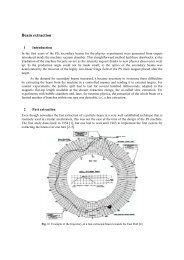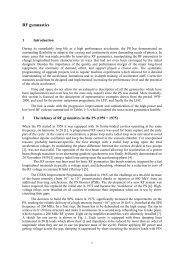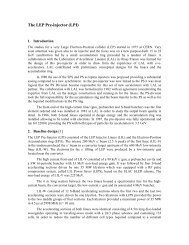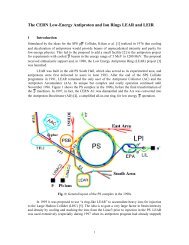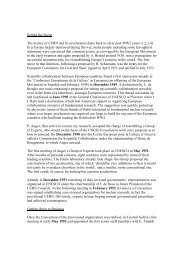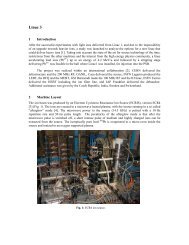The PS in the LEP injector chain - 50th anniversary of the CERN ...
The PS in the LEP injector chain - 50th anniversary of the CERN ...
The PS in the LEP injector chain - 50th anniversary of the CERN ...
Create successful ePaper yourself
Turn your PDF publications into a flip-book with our unique Google optimized e-Paper software.
<strong>The</strong> <strong>in</strong>jection positron kicker was located <strong>in</strong> SS94 and <strong>the</strong> electron kicker <strong>in</strong> SS72. <strong>The</strong> kicker fall-time<br />
was less than 250 ns, correspond<strong>in</strong>g to less than one eighth <strong>of</strong> <strong>the</strong> <strong>PS</strong> circumference. <strong>The</strong> kick strength<br />
(9 mrad) was strong enough that no slow <strong>in</strong>jection bump was necessary. S<strong>in</strong>gle-turn <strong>in</strong>jection was<br />
achieved through <strong>the</strong> electron (positron) <strong>in</strong>jection channel by means <strong>of</strong> a fast kicker magnet one eighth<br />
<strong>of</strong> a betatron wavelength downstream <strong>of</strong> a pulsed septum magnet. <strong>The</strong>re was no closed orbit bump <strong>in</strong><br />
<strong>the</strong> <strong>in</strong>jection area so as to avoid aperture restrictions.<br />
Chromaticity adjustments were performed with a small damp<strong>in</strong>g change at <strong>in</strong>jection us<strong>in</strong>g <strong>the</strong><br />
<strong>PS</strong> auxiliary w<strong>in</strong>d<strong>in</strong>gs. A small energy damp<strong>in</strong>g partition number change <strong>of</strong> ΔJ e = −0.5 was obta<strong>in</strong>ed<br />
through an unbalanced comb<strong>in</strong>ed-function bend<strong>in</strong>g magnet field us<strong>in</strong>g <strong>the</strong> <strong>PS</strong> auxiliary w<strong>in</strong>d<strong>in</strong>g<br />
figure-<strong>of</strong>-eight loop. <strong>The</strong> ensu<strong>in</strong>g tune change was cancelled by power<strong>in</strong>g <strong>the</strong> focus<strong>in</strong>g and defocus<strong>in</strong>g<br />
pole-face-w<strong>in</strong>d<strong>in</strong>g coils. <strong>The</strong> sextupolar component <strong>of</strong> <strong>the</strong>se coils modified <strong>the</strong> chromaticities and<br />
made <strong>the</strong>m positive <strong>in</strong> both planes, as required to avoid head–tail <strong>in</strong>stabilities.<br />
4 Emittance control <strong>of</strong> <strong>the</strong> <strong>PS</strong> lepton beams us<strong>in</strong>g a Rob<strong>in</strong>son wiggler<br />
In 1958, Rob<strong>in</strong>son <strong>of</strong> <strong>the</strong> Cambridge electron accelerator (Massachusetts) proposed that a gradient<br />
wiggler magnet be used to stabilize naturally unstable electron and positron beams <strong>in</strong> comb<strong>in</strong>edfunction<br />
mach<strong>in</strong>es. In 1986 such a method was applied <strong>in</strong> <strong>the</strong> <strong>PS</strong> so that it could serve as an<br />
accelerator <strong>in</strong> <strong>the</strong> <strong>LEP</strong> <strong>in</strong>jector cha<strong>in</strong>. A prototype wiggler magnet was designed and constructed at<br />
<strong>CERN</strong>. As predictions were confirmed by measurements carried out <strong>in</strong> <strong>the</strong> <strong>PS</strong> with electrons and <strong>in</strong><br />
<strong>the</strong> DCI (LAL, Orsay, France) with positrons to check <strong>the</strong> damp<strong>in</strong>g variations produced by this<br />
wiggler, three wigglers were <strong>in</strong>stalled <strong>in</strong> <strong>the</strong> <strong>PS</strong> as it was part <strong>of</strong> <strong>the</strong> <strong>LEP</strong> <strong>in</strong>jector cha<strong>in</strong> [5].<br />
A Rob<strong>in</strong>son gradient wiggler magnet consists <strong>of</strong> an even number <strong>of</strong> comb<strong>in</strong>ed dipole–<br />
quadrupole magnet blocks <strong>of</strong> identical pole pr<strong>of</strong>ile. <strong>The</strong> orientation <strong>of</strong> <strong>the</strong> pole pr<strong>of</strong>ile is <strong>the</strong> same <strong>in</strong><br />
all four blocks with field and gradient <strong>of</strong> alternat<strong>in</strong>g polarity. <strong>The</strong> overall beam deflection is cancelled<br />
by power<strong>in</strong>g <strong>the</strong> half <strong>of</strong> <strong>the</strong> blocks with opposite polarities. To first-order this restricts <strong>the</strong> closed-orbit<br />
perturbation and <strong>of</strong>fsets <strong>the</strong> quadrupole focus<strong>in</strong>g.<br />
<strong>The</strong> damp<strong>in</strong>g <strong>of</strong> betatron and energy oscillations is proportional to <strong>the</strong> damp<strong>in</strong>g partition<br />
numbers J x , J y , J e which can be expressed <strong>in</strong> terms <strong>of</strong> synchrotron radiation <strong>in</strong>tegrals I 2 and I 4 where D x<br />
is <strong>the</strong> dispersion function, B y <strong>the</strong> magnetic field, ρ x <strong>the</strong> curvature radius, and k x =(B y ρ x ) -1 ∂B y /∂x <strong>the</strong><br />
normalized gradient<br />
1 <br />
<br />
1 2 <br />
<br />
with (assum<strong>in</strong>g a planar r<strong>in</strong>g and wiggler sector magnets for simplicity)<br />
<br />
<br />
<br />
<br />
<br />
12 .<br />
An <strong>in</strong>dividual wiggler magnet adds a contribution ΔI 4 to I 4 and a small positive amount ΔI 2 to I 2<br />
∆ 2<br />
<br />
wiggler <br />
4<br />
<br />
Δ <br />
<br />
wiggler <br />
<br />
If <strong>the</strong> gradient wiggler is such that field and gradient are <strong>of</strong> opposite sign (i.e., B y ∂B y /dx < 0), its<br />
contribution to ΔI 4 is negative and consequently ΔJ x is positive (though ΔI 2 > 0 slightly lessens <strong>the</strong><br />
positive change <strong>of</strong> J x ) and damp<strong>in</strong>g is <strong>in</strong>creased <strong>in</strong> <strong>the</strong> horizontal plane. Hence <strong>the</strong> gradient wiggler<br />
magnet <strong>in</strong>creases <strong>the</strong> damp<strong>in</strong>g <strong>of</strong> radial betatron oscillations and decreases <strong>the</strong> damp<strong>in</strong>g <strong>of</strong> energy<br />
oscillations (J e = 2 + I 4 /I 2 ).<br />
Equilibrium transverse emittances and energy spread are reached when <strong>the</strong> mean quantum<br />
excitation rates are equal to damp<strong>in</strong>g rates<br />
.



